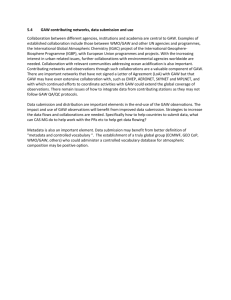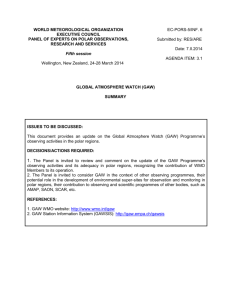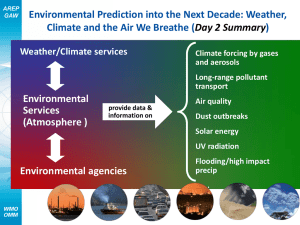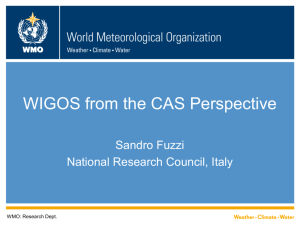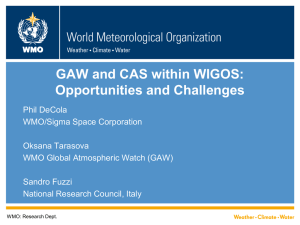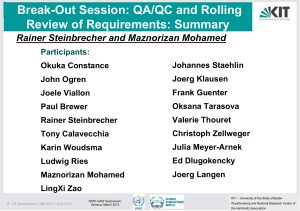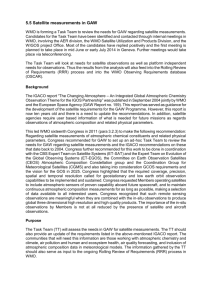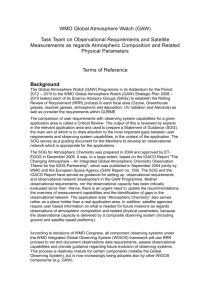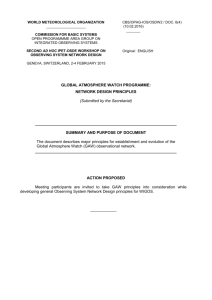WORLD METEOROLOGICAL ORGANIZATION
advertisement
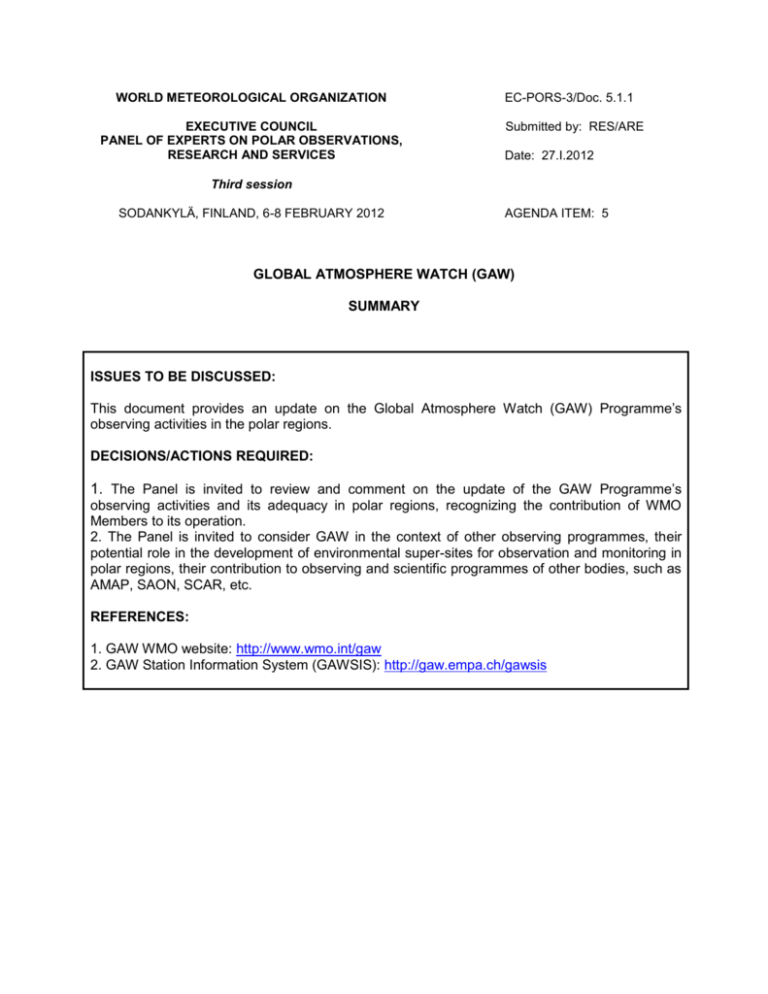
WORLD METEOROLOGICAL ORGANIZATION EXECUTIVE COUNCIL PANEL OF EXPERTS ON POLAR OBSERVATIONS, RESEARCH AND SERVICES EC-PORS-3/Doc. 5.1.1 Submitted by: RES/ARE Date: 27.I.2012 Third session SODANKYLÄ, FINLAND, 6-8 FEBRUARY 2012 AGENDA ITEM: 5 GLOBAL ATMOSPHERE WATCH (GAW) SUMMARY ISSUES TO BE DISCUSSED: This document provides an update on the Global Atmosphere Watch (GAW) Programme’s observing activities in the polar regions. DECISIONS/ACTIONS REQUIRED: 1. The Panel is invited to review and comment on the update of the GAW Programme’s observing activities and its adequacy in polar regions, recognizing the contribution of WMO Members to its operation. 2. The Panel is invited to consider GAW in the context of other observing programmes, their potential role in the development of environmental super-sites for observation and monitoring in polar regions, their contribution to observing and scientific programmes of other bodies, such as AMAP, SAON, SCAR, etc. REFERENCES: 1. GAW WMO website: http://www.wmo.int/gaw 2. GAW Station Information System (GAWSIS): http://gaw.empa.ch/gawsis EC-PORS-3/Doc. 5.1.1, p. 2 5.1 OBSERVATION PROGRAM UPDATES GLOBAL ATMOSPHERE WATCH (GAW) Discussion Reference is made to EC-PORS-1/Doc 5.1.2. and EC-PORS-2/Doc 5.1.2. in which statistics are provided on the GAW stations and measurement programme over the polar regions. In this document a brief update on the network is provided and some critical issues are highlighted. The WMO Global Atmosphere Watch (GAW) Programme continues the coordination of global observations of greenhouse gases (GHG), ozone, UV radiation, aerosols, selected reactive gases, and precipitation chemistry. The most extensive measurement programmes are implemented by the GAW Global stations (information is available from the GAW Station Information System (GAWSIS) at http://gaw.empa.ch/gawsis/). Six of the 27 Global stations are situated in the Polar Regions (North of 60N or South of 60S) and remain operational: Alert, Barrow, Pallas/Sodankylä, Ny Ålesund in the Arctic region and Neumayer and South Pole in Antarctica. The key challenges in Arctic observations remain: Aerosols pollution related to Arctic haze, Assessment of direct pollutant transport from the sources in the Northern hemisphere (via reactive gases observations) Changes in the sources and sinks of greenhouse gases due to permafrost melting and sea shelf warming, Stratospheric ozone depletion In the Antarctic, the focus remains on stratospheric ozone depletion. The four GAW Global stations in the Arctic (Alert (Canada), Point Barrow Observatory (United States, Alaska), Pallas-Sodankylä (Finland), Ny-Ålesund (Norway)) have adequate measurement programmes to address the bulk of the issues identified. Ny-Ålesund has the most comprehensive aerosol and reactive gases measurement programme. The suite of measurements has become very complex and challenging to support in a sustainable manner. As a matter of fact, many of the observational sites experience substantial problems with funding. On the other hand, a thorough analysis and understanding of the total atmospheric chemistry and aerosol impact is only possible if many species or groups of species are measured. Therefore, such comprehensive measurements should, despite their complexity, be encouraged and supported to avoid premature termination (such as the greenhouse gases isotopes measurements which were ceased by some countries in the past year).It is of concern that during recent years a substantial reduction in GAW observations has occurred in the Arctic in particular; of the 54 stations registered in GAWSIS over the Arctic, 30% are reported as closed. However, when checking data submissions and availability it is clear that the situation is in fact worse. Substantial gaps exist in the Arctic observations in specific critical regions where climate change is already impacting on the fluxes of the greenhouse gases and is projected to continue to do so in future. The commissioning of the observation station at Tiksi, which has performed GHG observations since mid-2010 is a prime example of such a location. Cg-XVI applauded this commitment by the Russian Federation, and the station was accepted as a GAW regional EC-PORS-3/Doc. 5.1.1, p. 3 station in 2011. However, routine data submission to the World Data Centre for Greenhouse Gasses, a requirement for such a station, still has to be initiated. On Antarctica, two Global GAW stations (Neumayer Station (operated by Germany) and the South Pole Observatory (operated by the United States)) remain operational. Neumayer stations submits only data on surface ozone and vertical ozone profiles, while South Pole has more comprehensive programme with appropriate data submission for a substantial number of reactive and greenhouse gases as well as ozone profiles. Only 2 stations in Antarctica measure CFCs, which are considered to be the cause of the stratospheric ozone depletion. The spatial coverage of observations in Antarctica is very sparse, even compared to the Artic. Due to the high costs and logistical difficulties to run the stations in Antarctica, they run a high risk for closure during periods of financial strain. Nearly half of the earlier active Regional stations (12 of 30) have closed in Antarctica while many of the “fully operational stations” do not have data submissions for the last two years (8 of remaining 18). Summary Considering the observed and projected changes in polar regions, their importance to the global weather and climate system and the emerging needs for new weather and climate services in polar regions, it should be noted that: GAW is a fundamental programme to build a better understanding of the various feedbacks that occur in polar regions and to improve modeling of the weather and climate system; The GAW observation activities are coming under increasing threat due to financial pressure exactly at a time when their value is increasing; Models being develop for new environmental services in polar regions require more comprehensive atmospheric chemistry and aerosol information at higher special resolution In is therefore desirable to promote the notion that, despite the complexity of the measurement programme related to atmospheric chemistry and aerosols over polar regions, such programmes should be expanded and be viewed as an integral part of sustained routine observations. Members of WMO should be encouraged to find ways to ensure that such programmes become less dependent of project funds related to research initiatives. Acronyms CFCs GAW GAWSIS GHG Chlorofluorocarbons Global Atmosphere Watch Programme of the World Meteorological Organization GAW Station Information System Greenhouse Gas
